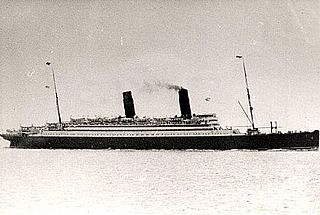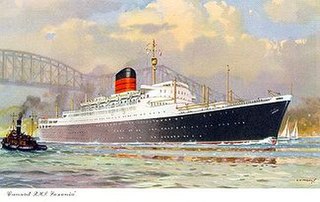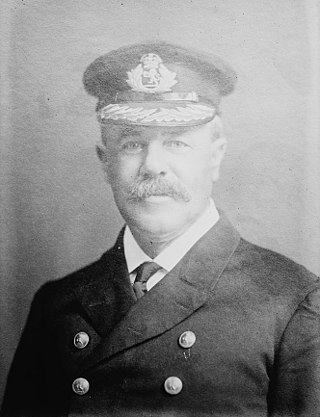
RMS Queen Elizabeth was an ocean liner operated by Cunard Line. Along with the Queen Mary, she provided a weekly transatlantic service between Southampton in the United Kingdom and New York City in the United States, via Cherbourg in France.

An ocean liner is a type of passenger ship primarily used for transportation across seas or oceans. Ocean liners may also carry cargo or mail, and may sometimes be used for other purposes. The Queen Mary 2 is the only ocean liner still in service to this day.

RMS Caronia was a 34,183 gross register tons (GRT) passenger ship of the Cunard Line. Launched on 30 October 1947, she served with Cunard until 1967. She was nicknamed the "Green Goddess" after her light green hull livery. She was one of the first "dual-purpose" ships, built both for 2-class transatlantic crossings and all 1st-class cruising. After leaving Cunard she was briefly Caribia in 1969, after which she was laid up in New York until 1974, when she was sold for scrap. While being towed to Taiwan for scrapping, she was caught in a storm on 12 August. After her tow lines were cut, she repeatedly crashed on the rocky breakwater outside Apra Harbor, Guam and broke into three sections.

RMS Aquitania was an ocean liner of the Cunard Line in service from 1914 to 1950. She was designed by Leonard Peskett and built by John Brown & Company in Clydebank, Scotland. She was launched on 21 April 1913 and sailed on her maiden voyage from Liverpool to New York on 30 May 1914. She was given the title of Royal Mail Ship (RMS) like many other Cunard ocean liners since she carried the royal mail on many of her voyages. Aquitania was the third in Cunard Line's grand trio of express liners, preceded by RMS Mauretania and RMS Lusitania, and was the last surviving four-funnelled ocean liner. Shortly after Aquitania entered service, the First World War broke out, during which she was first converted into an auxiliary cruiser before being used as a troop transport and a hospital ship, notably as part of the Dardanelles Campaign.

A troopship is a ship used to carry soldiers, either in peacetime or wartime. Troopships were often drafted from commercial shipping fleets, and were unable to land troops directly on shore, typically loading and unloading at a seaport or onto smaller vessels, either tenders or barges.

SS Imperator was a German ocean liner built for the Hamburg America Line, launched in 1912. At the time of her completion in June 1913, she was the largest passenger ship in the world, surpassing the new White Star liner Olympic.

RMS Caronia was a Cunard Line transatlantic steam ocean liner. She was launched in 1904 and scrapped in 1932. In World War I she was first an armed merchant cruiser (AMC) and then a troop ship.

Sir Arthur Henry Rostron, KBE, RD was a British merchant seaman and a seagoing officer for the Cunard Line. He is best known as the captain of the ocean liner RMS Carpathia, when it rescued the survivors from the RMS Titanic after the ship sank in 1912 in the middle of the North Atlantic Ocean.
Parsons Marine Steam Turbine Company was a British engineering company based on the River Tyne at Wallsend, North East England.

SS Cap Trafalgar was a German ocean liner launched in 1913 for the Hamburg Süd line. In 1914, she was converted for use as an auxiliary cruiser during World War I. She was the first armed merchant cruiser sunk by a ship of the same class; she was destroyed by HMS Carmania, also a converted ocean liner, in a furious action in the South Atlantic on 14 September 1914. It was the world's first battle between former ocean liners.
RMS Carmania may refer to the following ocean liners:

RMS Carmania was a Cunard Line transatlantic steam turbine ocean liner. She was launched in 1905 and scrapped in 1932. In World War I she was first an armed merchant cruiser (AMC) and then a troop ship.

RMS Saxonia was a British passenger liner built by John Brown & Company at Clydebank, Scotland for the Cunard Steamship Company for their Liverpool-Montreal service. She was the first of four almost identical sister ships built by Browns between 1954 and 1957 for UK-Montreal service. The first two of these ships, Saxonia and Ivernia were extensively rebuilt in 1962/3 as dual purpose liner/cruise ships. They were renamed Carmania and Franconia respectively and painted in the same green cruising livery as the Caronia. Carmania continued transatlantic crossings and cruises until September 1967 when she closed out Cunard's Montreal service. She and her sister had been painted white at the end of 1966 and from 1968 Carmania sailed as a full time cruise ship until withdrawal after arriving at Southampton on 31 October 1971. In August 1973 she was bought by the Soviet Union-based Black Sea Shipping Company and renamed SS Leonid Sobinov. The ship was scrapped in 1999.
Caronia is a town in Italy.
RMS Franconia may refer to the following specific vessels:

James Clayton Barr was a Senior Commodore of the Cunard line.
RMS Saxonia may refer to:

The first RMS Saxonia was a passenger ship of the British Cunard Line. Between 1900 and 1925, Saxonia operated on North Atlantic and Mediterranean passenger routes, and she saw military service during World War I (1914–1918).

Sir James Gordon Partridge Bisset, CBE, RD was a British merchant sea captain who served as Commodore of the Cunard White Star Line (1944–47). He documented his fifty-year sea career in a three volume autobiography: Sail Ho! My Early Years at Sea (1958); Tramps and Ladies – My Early Years in Steamers (1959) and Commodore – War, Peace and Big Ships (1961). In addition, Bisset authored Lifeboat Efficiency (1924) which became the primary text used by the British Merchant Marine until the Second World War for instructing merchant seaman in lifeboat utilization and handling, and Ship Ahoy ! : Nautical Notes for Ocean Travellers (c.1930), a treatise on shipboard operations for the edification of passengers. He served in or commanded Cunard liners including Carpathia, Caronia, Franconia, Mauretania, Aquitania, Berengaria, Queen Mary and Queen Elizabeth.

Leonard Peskett, OBE was the Cunard Line's Senior naval architect, designer and the designer of the company's ocean liners RMS Mauretania, RMS Lusitania, RMS Aquitania, and the RMS Carmania.














